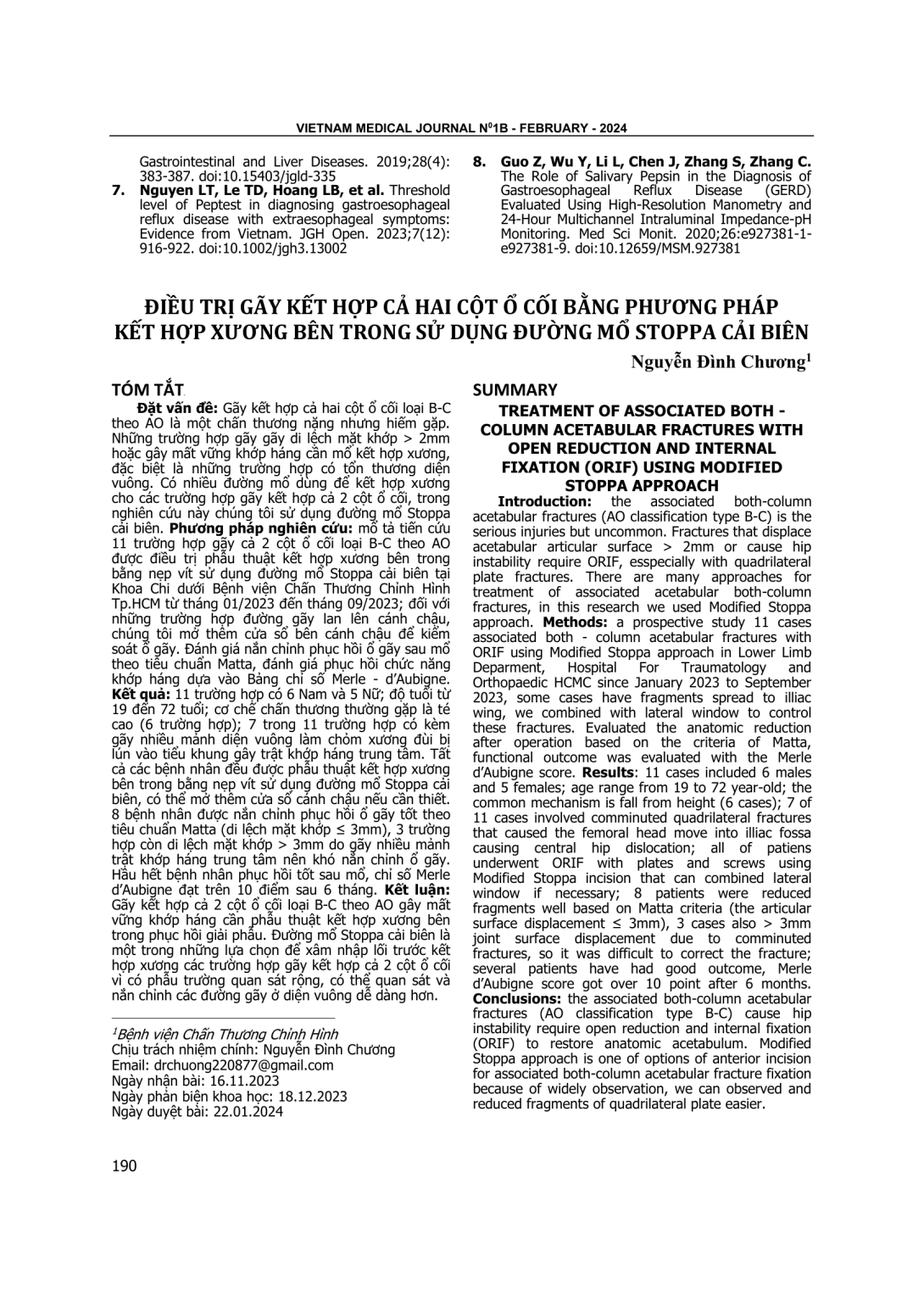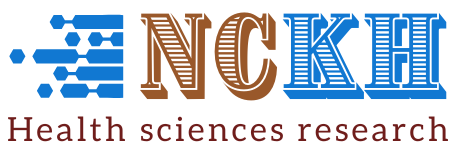
Gãy kết hợp cả hai cột ổ cối loại B-C theo AO là một chấn thương nặng nhưng hiếm gặp. Những trường hợp gãy gãy di lệch mặt khớp > 2mm hoặc gây mất vững khớp háng cần mổ kết hợp xương, đặc biệt là những trường hợp có tổn thương diện vuông. Có nhiều đường mổ dùng để kết hợp xương cho các trường hợp gãy kết hợp cả 2 cột ổ cối, trong nghiên cứu này chúng tôi sử dụng đường mổ Stoppa cải biên. Phương pháp nghiên cứu: mổ tả tiến cứu 11 trường hợp gãy cả 2 cột ổ cối loại B-C theo AO được điều trị phẫu thuật kết hợp xương bên trong bằng nẹp vít sử dụng đường mổ Stoppa cải biên tại Khoa Chi dưới Bệnh viện Chấn Thương Chỉnh Hình Tp.HCM từ tháng 01/2023 đến tháng 09/2023; đối với những trường hợp đường gãy lan lên cánh chậu, chúng tôi mở thêm cửa sổ bên cánh chậu để kiểm soát ổ gãy. Đánh giá nắn chỉnh phục hồi ổ gãy sau mổ theo tiêu chuẩn Matta, đánh giá phục hồi chức năng khớp háng dựa vào Bảng chỉ số Merle - d’Aubigne. Kết quả: 11 trường hợp có 6 Nam và 5 Nữ; độ tuổi từ 19 đến 72 tuổi; cơ chế chấn thương thường gặp là té cao (6 trường hợp); 7 trong 11 trường hợp có kèm gãy nhiều mảnh diện vuông làm chỏm xương đùi bị lún vào tiểu khung gây trật khớp háng trung tâm. Tất cả các bệnh nhân đều được phẫu thuật kết hợp xương bên trong bằng nẹp vít sử dụng đường mổ Stoppa cải biên, có thể mở thêm cửa sổ cánh chậu nếu cần thiết. 8 bệnh nhân được nắn chỉnh phục hồi ổ gãy tốt theo tiêu chuẩn Matta (di lệch mặt khớp ≤ 3mm), 3 trường hợp còn di lệch mặt khớp > 3mm do gãy nhiều mảnh trật khớp háng trung tâm nên khó nắn chỉnh ổ gãy. Hầu hết bệnh nhân phục hồi tốt sau mổ, chỉ số Merle d’Aubigne đạt trên 10 điểm sau 6 tháng. Kết luận: Gãy kết hợp cả 2 cột ổ cối loại B-C theo AO gây mất vững khớp háng cần phẫu thuật kết hợp xương bên trong phục hồi giải phẫu. Đường mổ Stoppa cải biên là một trong những lựa chọn để xâm nhập lối trước kết hợp xương các trường hợp gãy kết hợp cả 2 cột ổ cối vì có phẫu trường quan sát rộng, có thể quan sát và nắn chỉnh các đường gãy ở diện vuông dễ dàng hơn.
the associated both-column acetabular fractures (AO classification type B-C) is the serious injuries but uncommon. Fractures that displace acetabular articular surface > 2mm or cause hip instability require ORIF, esspecially with quadrilateral plate fractures. There are many approaches for treatment of associated acetabular both-column fractures, in this research we used Modified Stoppa approach. Methods: a prospective study 11 cases associated both - column acetabular fractures with ORIF using Modified Stoppa approach in Lower Limb Deparment, Hospital For Traumatology and Orthopaedic HCMC since January 2023 to September 2023, some cases have fragments spread to illiac wing, we combined with lateral window to control these fractures. Evaluated the anatomic reduction after operation based on the criteria of Matta, functional outcome was evaluated with the Merle d’Aubigne score. Results: 11 cases included 6 males and 5 females; age range from 19 to 72 year-old; the common mechanism is fall from height (6 cases); 7 of 11 cases involved comminuted quadrilateral fractures that caused the femoral head move into illiac fossa causing central hip dislocation; all of patiens underwent ORIF with plates and screws using Modified Stoppa incision that can combined lateral window if necessary; 8 patients were reduced fragments well based on Matta criteria (the articular surface displacement ≤ 3mm), 3 cases also > 3mm joint surface displacement due to comminuted fractures, so it was difficult to correct the fracture; several patients have had good outcome, Merle d’Aubigne score got over 10 point after 6 months. Conclusions: the associated both-column acetabular fractures (AO classification type B-C) cause hip instability require open reduction and internal fixation (ORIF) to restore anatomic acetabulum. Modified Stoppa approach is one of options of anterior incision for associated both-column acetabular fracture fixation because of widely observation, we can observed and reduced fragments of quadrilateral plate easier.
- Đăng nhập để gửi ý kiến
